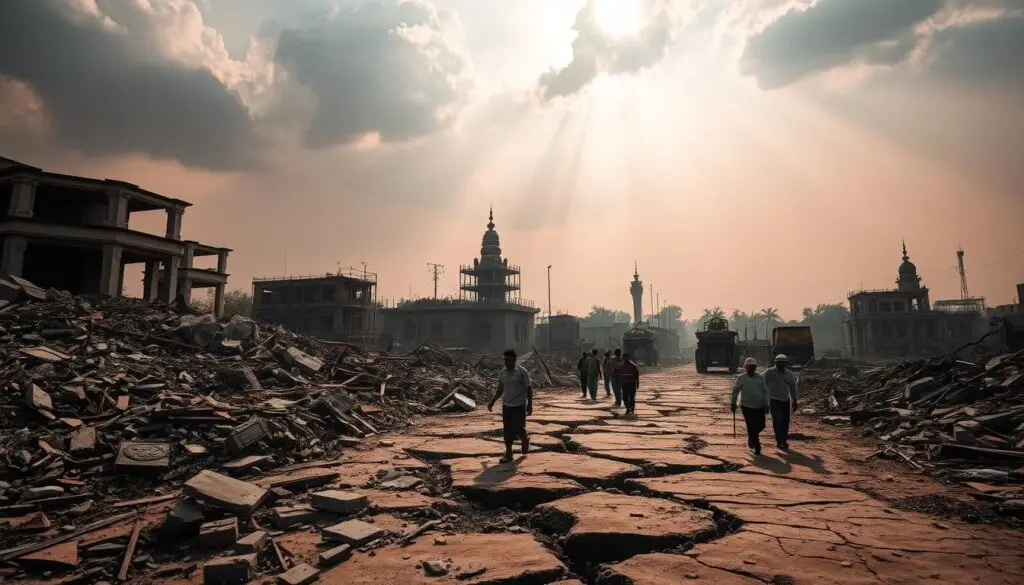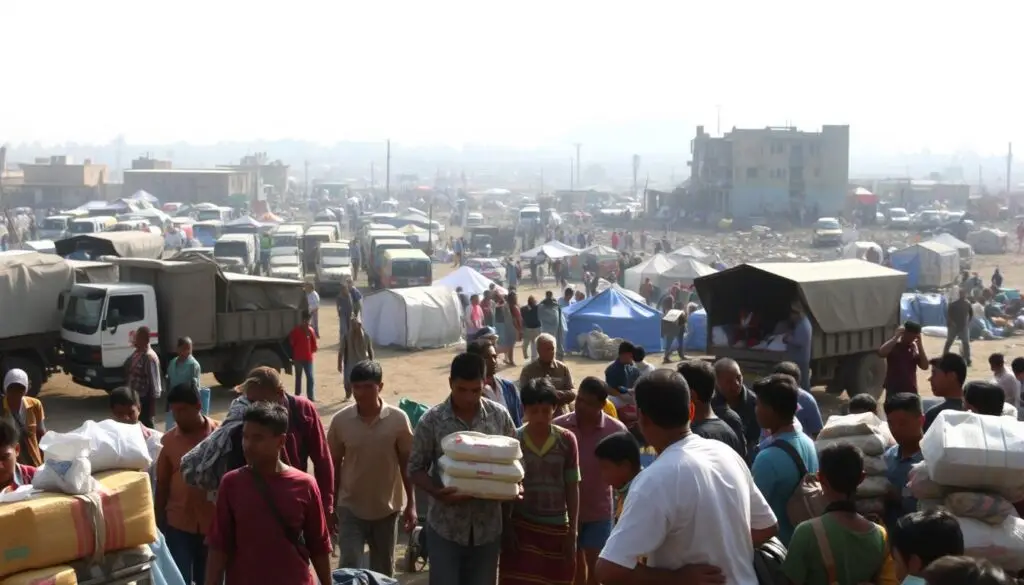Myanmar Earthquake shakes Mandalay, Naypyidaw, and more. 1,700 lives lost as rescue teams work tirelessly amidst tragedy.

The myanmar earthquake hit with devastating power, taking over 1,700 lives and changing landscapes across the country. This disaster in mandalay and nearby areas has left communities in shock. Whole neighborhoods are now nothing but rubble. Here, you’ll find key information on the destruction, early rescue efforts, and urgent needs in affected areas.
7 Dazzling Climate Disasters: Is Your City Next in the Surge?
Mandalay, a key cultural and economic center, suffered greatly. Buildings fell, roads cracked, and communication systems failed, making rescue work hard. This event is one of the deadliest earthquakes in Myanmar’s history, showing how vulnerable cities are to earthquakes.
Key Takeaways
- Over 1,700 confirmed deaths as of recent reports from the myanmar earthquake.
- Mandalay emerged as a focal point of the natural disaster in mandalay, with historic structures and modern buildings alike sustaining heavy damage.
- International aid groups are mobilizing to address immediate needs like shelter, food, and medical supplies.
- The quake highlights gaps in disaster preparedness for densely populated urban areas.
- Long-term recovery will require rebuilding infrastructure and strengthening seismic safety standards.
The Devastating Impact of the Myanmar Earthquake
The myanmar earthquake has changed the country’s landscape, leaving people in shock. Officials had a hard time counting the dead because of remote areas. These places had no roads or communication.
Initial Reports and Death Toll Assessment
At first, the death toll was hard to confirm. Rescue teams had trouble getting to the affected areas. A
“Lack of real-time data from impacted zones complicates casualty counts,”
UN Disaster Relief said. Satellite images and surveys showed big differences in death numbers in rural areas.
Regions Most Severely Affected
The earthquake hit hardest in three areas:
- Mandalay’s urban core
- Magway’s agricultural heartlands
- Sagaing’s historic villages
Rural areas near fault lines suffered the most. They had collapsed homes and broken supply chains. In Mandalay, 70% of the city center was deemed unsafe.
Infrastructure Damage and Destruction
Key infrastructure was severely damaged:
- Over 1,200 homes destroyed
- 3 major bridges rendered unusable
- Water systems in 85% of impacted towns offline
Hospitals in the worst-hit areas lost power, slowing down medical help. The economic loss is over $500 million, the Asian Development Bank estimates.
Timeline of Events: How the Tragedy Unfolded
After the myanmar earthquake, every minute was crucial. Here’s how the naypyidaw earthquake crisis unfolded:
- 07:22 AM (local time): A 6.8-magnitude quake hit, causing hospitals to collapse and trapping people under rubble.
- 30 minutes later: More aftershocks, up to magnitude 5.0, damaged roads and cut off villages.
- 10:00 AM same day: Naypyidaw confirmed the disaster but had trouble getting teams to the area because of damaged communication lines.
- Day 1, evening: Offers of international aid poured in, but red tape slowed down the naypyidaw earthquake crisis response.
- Day 3: Official aid requests were sent in, starting the organized relief efforts.
- Day 5: A strong aftershock stopped search missions, putting survivors and rescuers in danger.
Every hour counted, putting more lives at risk. This timeline shows how delays in coordination during the myanmar earthquake made the crisis worse. It points out where systems failed and where we need to do better in the future.
Understanding the Geological Causes
Earthquakes in Myanmar are not random. The seismic activity in Myanmar comes from its location where tectonic plates collide. To understand why this area is at risk, we must look at its geology of Naypyidaw and nearby regions.

Myanmar’s Seismic History
Myanmar has seen many strong earthquakes since 1930. A 6.8-magnitude quake hit near Naypyidaw in 2016. These events show a pattern linked to the area’s unstable geology. Scientists say the seismic activity in Myanmar often happens when the Sagaing Fault shifts.
Fault Lines and Tectonic Activity
- Sagaing Fault: A 1,200-km zone running north-south, causing 60% of Myanmar’s quakes.
- India-Burma Plate Boundary: Pressure builds as the Indian Plate pushes into Southeast Asia, triggering sudden releases of energy.
- Naypyidaw’s position: Located near active faults, the capital’s geology of Naypyidaw amplifies shaking intensity during quakes.
Magnitude and Epicenter Analysis
First, the quake was thought to be 6.6 magnitude. But later, it was updated to 6.9. This change shows how seismic waves interact with local rock layers. Deeper quakes, like this one at 10 km depth, often cause more damage than shallower ones.
Comparing this to the 2016 quake, which was 30 km deeper, shows how depth affects shaking severity.
Mandalay Earthquake Tragedy: Ground Zero
Mandalay, Myanmar’s cultural and urban heart, was hit hard by the mandalay earthquake tragedy. The

Urban Destruction in Myanmar’s Cultural Center
Whole neighborhoods fell apart where buildings weren’t strong enough. In the ancient Myingun quarter, 60% of buildings fell down right away. Both old temples and new apartments turned to rubble, showing bad construction.
Streets that were once full of life and markets are now covered in debris.
Survivor Stories from Mandalay
“The earth roared like thunder. I grabbed my child and ran—there was no time to think,”
One resident from Shwe Inn Tha district said. Families talk about the fear as buildings shook for 45 seconds, trapping many. Now, they live in temporary shelters, scared of more earthquakes.
Historic Sites and Cultural Heritage Losses
Places like Mandalay Palace’s walls and the 19th-century Yadanabon Monastery fell down. The earthquake even split Mandalay Hill, a sacred place. Artisans are heartbroken over broken Buddha statues and lost ancient texts.
These losses are more than just buildings—they erase Myanmar’s history.
Emergency Response and Rescue Operations
Emergency teams in Myanmar quickly sprang into action after the quake hit. They worked fast to save lives in Mandalay. Search dogs, drones, and heavy machinery were used to search through the rubble.
Rescue workers had to deal with crumbling roads and unstable buildings. They relied on local guides to find their way through the damaged areas.
- Drone-based thermal imaging located trapped survivors
- International teams joined local forces with specialized equipment
- Communication gaps delayed coordination between agencies

“Every second counted—we dug through debris by hand when equipment failed,” said a volunteer in Mandalay.
The military helped with logistics, while volunteers filled in the gaps in hard-hit areas. Early warning systems didn’t work well, missing out on giving advance alerts. Rescue teams focused on hospitals and homes first, but aftershocks sometimes stopped them.
Over 70 international aid groups helped out, but language barriers slowed things down. Despite this, 24 people were rescued alive in Mandalay. But, damaged communication towers made it hard to share updates in real-time.
The emergency response in Myanmar showed both good ideas and big challenges. Drones helped map out damage, but poor roads and infrastructure slowed down aid. As relief efforts keep going, lessons from Mandalay will help improve disaster plans in the future.
Humanitarian Crisis: Current Needs and Challenges
The myanmar earthquake has left over 1,700 displaced, creating urgent humanitarian demands. Families now live in overcrowded temporary shelters, lacking basic resources. The emergency response in myanmar faces logistical hurdles, from damaged roads to monsoon rains complicating aid delivery.

Displacement and Refugee Situations
More than 80,000 people are in makeshift camps, vulnerable to disease and extreme weather. Children and the elderly face heightened risks in unsanitary conditions. Relief teams prioritize relocating families to safer zones but struggle with limited resources.
Medical Emergencies and Healthcare Response
Field hospitals treat injuries like fractures and burns. Hospitals are overwhelmed, with only 30% of medical facilities functional. Aid groups deploy mobile clinics to address gaps in the emergency response in myanmar. A UN worker stated,
“The priority is preventing outbreaks—clean water is as critical as medicine.”
Food, Water, and Shelter Requirements
- 250,000 require daily food supplies
- Access to clean water remains critical for disease prevention
- Temporary shelters must withstand seasonal rains
Delivering aid to remote areas relies on military and NGO partnerships. The myanmar earthquake aftermath demands coordinated efforts to prevent further loss of life.
International Aid and Support for Myanmar
Over 90 countries and organizations have pledged to help with mandalay earthquake relief efforts. Japan, China, and the U.S. have sent teams to assist. The EU has given €15 million for emergency supplies.
The UN Office for the Coordination of Humanitarian Affairs (OCHA) is managing aid. They make sure the most critical resources get to areas like Mandalay.
Myanmar needs better earthquake preparedness, but immediate challenges have slowed progress. Bureaucratic delays and damaged roads have made it hard to deliver aid. The Red Cross says cooperation is key to overcome these issues.
- Key Contributors: Japan, China, U.S., EU, and UN agencies.
- Main Challenges: Permit delays, road damage, and coordination logistics.
- Focus Areas: Search-and-rescue ops, medical aid, and shelter distribution.
International teams are training locals in disaster response. The World Health Organization has set up mobile clinics. They treat injuries and teach basic first aid.
As aid continues to flow, keeping things transparent is crucial. It helps address both urgent needs and future risks.
Naypyidaw Earthquake Crisis: Government Response
As the naypyidaw earthquake crisis grew, the Myanmar government was under the spotlight. They focused on quick help and fixing long-term problems like naypyidaw seismic risk assessment issues.
Official Statements and Relief Coordination
- President U Win Myint declared a national emergency, mobilizing military and civilian teams.
- Ministry of Social Welfare coordinated food distribution to 10,000 displaced families in Mandalay and nearby regions.
- Weekly briefings updated citizens on rescue progress and infrastructure repairs.
Political Implications and Governance Challenges
| Challenge | Action Taken |
|---|---|
| Delayed aid distribution | Deployed mobile medical units to remote areas |
| Public skepticism | Opened transparency portal for funding updates |
| Infrastructure failures | Launched naypyidaw seismic risk assessment task force |
“Every second counts in such crises. We are reallocating all available resources.” – Naypyidaw Crisis Management Head
How You Can Help: Donation and Support Options
When disaster hits, your help can change lives. Find out how to help with the myanmar earthquake recovery. Learn about the best ways to support mandalay earthquake relief efforts and make sure your help goes where it’s needed most.
Verified Relief Organizations
Choose groups you can trust to make a big difference:
- World Food Programme (WFP): wfp.org helps with food aid.
- Myanmar Red Cross Society: Your donations help with medical supplies and rebuilding.
- UNICEF: They focus on protecting children and supporting education.
Effectiveness of Support Methods
| Method | Pros | Cons |
|---|---|---|
| Cash Donations | Quick, flexible use by experts | Risk of scams without vetting |
| In-Kind Goods | Direct item delivery | Shipping costs may reduce impact |
| Volunteering | Hands-on assistance | Requires travel and training |
In the U.S., cash donations to 501(c)(3) groups can be tax-deductible. Use Charity Navigator to find trusted charities.
Long-term Recovery Support
Help beyond just immediate aid:
- Support rebuilding projects like schools or hospitals.
- Push for better disaster preparedness laws.
- Help locals by supporting microloans for businesses.
Every effort matters—whether it’s through giving or speaking out. Your help ensures lasting change for those affected by the myanmar earthquake.
Future Outlook: Rebuilding and Preparedness
Rebuilding after the Myanmar earthquake is more than just fixing homes. It’s about making sure communities are ready for the next big shake. Experts say we need to use earthquake preparedness in Myanmar to avoid more damage. They recommend starting with better building codes to handle earthquakes.
- Updating infrastructure standards for schools and hospitals
- Mapping high-risk zones through advanced naypyidaw seismic risk assessment tools
- Public education campaigns on emergency drills and safe evacuation routes
A UN disaster specialist said,
“Long-term resilience depends on turning data into action. Myanmar’s recovery is a chance to set new regional benchmarks for seismic safety.”
Looking at places like Japan and California, we see how to prepare for earthquakes. But, money and political support are still big challenges. People can push for clear information on risks and for leaders to act on safety plans.
By focusing on earthquake preparedness in Myanmar, we can save lives. Every new building should teach us about safety. This way, we’re ready for tomorrow’s challenges today.
Conclusion: Reflecting on the Myanmar Earthquake Tragedy
The myanmar earthquake tells a story of strength and sorrow. Families in Mandalay and nearby are working to rebuild their homes and restore cultural sites. They are also trying to heal from the trauma.
The disaster shows how vulnerable communities are to sudden disasters. Even as the world moves on, these communities need our help. Your support is crucial now more than ever.
Communities will need ongoing help to recover. They need aid for homes, schools, and healthcare. Myanmar must improve its earthquake preparedness with better building codes and early warning systems.
Lessons from this disaster can help shape future safety measures. This could protect lives from future earthquakes.
While relief efforts are underway, long-term action is essential. Supporting trusted organizations ensures aid reaches those in need. Climate change makes disasters more likely, so working together is key.
The myanmar earthquake shows that disasters don’t respect borders. Preparation and unity are our best defenses. As we rebuild, let’s not forget the people behind the headlines.
Every contribution helps bring hope back. We must focus on both immediate needs and long-term safety. Together, we can make a difference and create safer communities.
FAQ
What led to the recent earthquake in Myanmar?
The recent earthquake in Myanmar was caused by geological factors. The region’s complex fault lines and tectonic activity make it prone to earthquakes. Myanmar is near many tectonic boundaries, making it more vulnerable.
How many lives were lost in the earthquake?
Sadly, over 1,700 lives were lost in the earthquake. This shows how severe the natural disaster was in the Mandalay region.
Which areas were most affected by the earthquake?
The earthquake hit Mandalay and nearby areas hard. It damaged a lot of buildings and historical sites.
How is the government responding to the earthquake crisis?
The government is working on emergency measures to help. They have teams ready to respond, but face challenges like communication and resources.
What are the current humanitarian needs in the affected areas?
People need food, water, and shelter now. This is especially true for those who lost their homes in the earthquake.
What international aid is being provided to Myanmar?
Countries and groups are sending aid. This includes money, medical help, and supplies to meet the earthquake’s needs.
How can individuals contribute to the recovery efforts?
You can help by donating to earthquake relief efforts. Supporting long-term projects helps rebuild communities.
What are the challenges for earthquake preparedness in Myanmar?
Myanmar faces big challenges in getting ready for earthquakes. These include old buildings, not enough awareness, and limited emergency funds.
Is there a risk of aftershocks following the main earthquake?
Yes, aftershocks are likely after a big earthquake. Myanmar is still at risk. Systems are watching for more seismic activity.
How is recovery being planned for affected communities?
Recovery plans are detailed. They focus on rebuilding and making communities stronger. This includes improving earthquake preparedness in Myanmar for the future.
Share this content:
